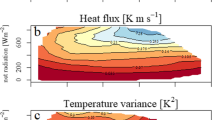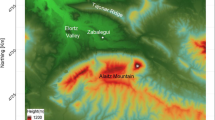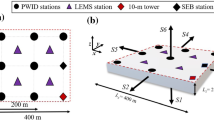Abstract
We examine the efficacy of two methods commonly used to estimate the vertical turbulent fluxes of momentum and sensible heat from routinely observed mean quantities in the surface layer under stable stratification. The single-level method uses mean wind speed and temperature measurements at a single height, whereas the two-level method uses mean wind speed measurements at a single height and mean temperature measurements at two heights. These methods are used in popular meteorological processors such as the U.S. Environmental Protection Agency approved AERMET and CALMET to generate inputs for dispersion simulations. We use data from a flux station of the U.K. Met Office at Cardington for comparison. It is found that the single-level method does not describe the flux variation in the weakly stable regime at all, because of its assumption that the temperature scale, i.e. the ratio of the kinematic sensible heat flux to the friction velocity, is constant, which is plausible only under strongly stable conditions. On the other hand, the two-level method provides a physically realistic variation of the fluxes with stability, but the required temperature measurements at two levels are usually not available on a routine basis. If measurements of the standard deviation of temperature are also available, in addition to the mean temperature at a single level, then they can be usefully employed in a third (single-level) method, with the consequence that the computed fluxes are very similar to those obtained from the two-level method. An improvement to the original single-level method is considered, and flux calculations under low wind conditions are also discussed.
Similar content being viewed by others
References
Basu S, Holtslag AAM, van de Wiel BJH, Moene AF, Steeneveld G-J (2008) An inconvenient “truth” about using sensible heat flux as a surface boundary condition in models under stably stratified regimes. Acta Geophys 56: 88–99
Cimorelli AJ, Perry SG, Venkatram A, Weil JC, Paine RJ, Wilson RB, Lee RF, Peters WD, Brode RW (2005) AERMOD: a dispersion model for industrial source applications. Part I: General model formulation and boundary layer characterization. J Appl Meteorol 44: 682–693
EPA (2004a) User’s guide for the AERMOD meteorological preprocessor (AERMET). EPA-454/B-03-002. U.S. Environmental Protection Agency, Research Triangle Park, NC (USA), 252 pp. http://www.epa.gov/scram001/metobsdata_procaccprogs.htm#aermet
EPA (2004b) AERMOD: description of model formulation. EPA-454/R-03-004. U.S. Environmental Protection Agency, Research Triangle Park, NC (USA), 91 pp. http://www.epa.gov/scram001/7thconf/aermod/aermod_mfd.pdf
Holtslag AAM (1984) Estimates of diabatic wind speed profiles from near-surface weather observations. Boundary-Layer Meteorol 29: 225–250
Holtslag AAM, van Ulden AP (1982) Simple estimates of nighttime surface fluxes from routine weather data. Scientific Report 82-4. Royal Netherlands Meteorological Institute, De Bilt, 15 pp
Hsieh C-I, Katul G, Chi T-W (2000) An approximate analytical model for footprint estimation of scalar fluxes in thermally stratified atmospheric flows. Adv Water Resour 23: 765–772
Luhar AK, Hurley PJ, Rayner KN (2009) Modelling near-surface low winds over land under stable conditions: sensitivity tests, flux–gradient relationships, and stability parameters. Boundary-Layer Meteorol 130: 249–274
Princevac M, Venkatram A (2007) Estimating micrometeorological inputs for modeling dispersion in urban areas during stable conditions. Atmos Environ 41: 5345–5356
Scire JS, Robe FR, Fernau ME, Yamartino RJ (2000a) A user’s guide for the CALMET meteorological model (version 5). Earth Tech, Inc., Concord, MA (USA), 332 pp. http://www.src.com/calpuff/download/CALMET_UsersGuide.pdf
Scire JS, Strimaitis DG, Yamartino RJ (2000b) A user’s guide for the CALPUFF dispersion model (version 5). Earth Tech, Inc., Concord, MA (USA), 521 pp. http://www.src.com/calpuff/download/CALPUFF_UsersGuide.pdf
Stull RB (1988) An introduction to boundary layer meteorology. Kluwer, Dordrecht, p 666
van de Wiel BJH, Moene AF, Steeneveld GJ, Hartogensis OK, Holtslag AAM (2007) Predicting the collapse of turbulence in stably stratified boundary layers. Flow Turbul Combust 79: 251–274
van Ulden AP (1978) Simple estimates for vertical diffusion from sources near the ground. Atmos Environ 12: 2125–2129
Venkatram A (1980) Estimating the Monin–Obukhov length in the stable boundary layer for dispersion calculations. Boundary-Layer Meteorol 19: 481–485
Venkatram A, Princevac M (2008) Using measurements in urban areas to estimate turbulent velocities for modeling dispersion. Atmos Environ 42: 3833–3841
Author information
Authors and Affiliations
Corresponding author
Rights and permissions
About this article
Cite this article
Luhar, A.K., Rayner, K.N. Methods to Estimate Surface Fluxes of Momentum and Heat from Routine Weather Observations for Dispersion Applications under Stable Stratification. Boundary-Layer Meteorol 132, 437–454 (2009). https://doi.org/10.1007/s10546-009-9409-z
Received:
Accepted:
Published:
Issue Date:
DOI: https://doi.org/10.1007/s10546-009-9409-z




